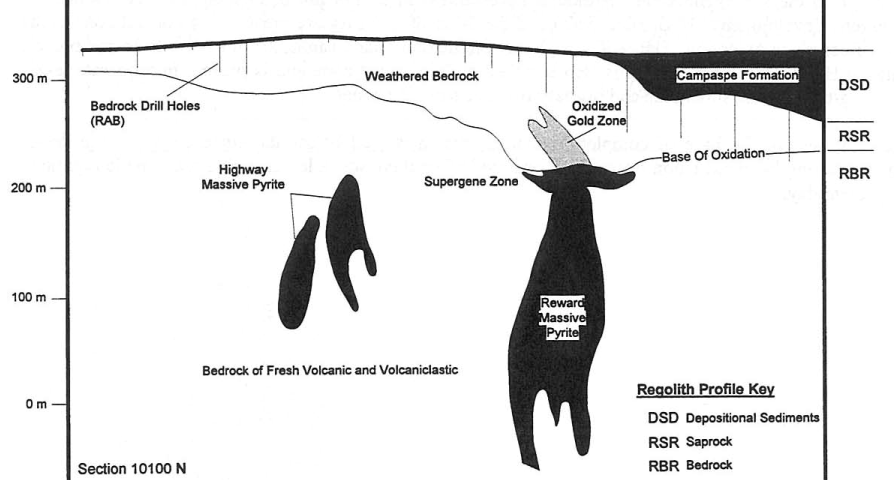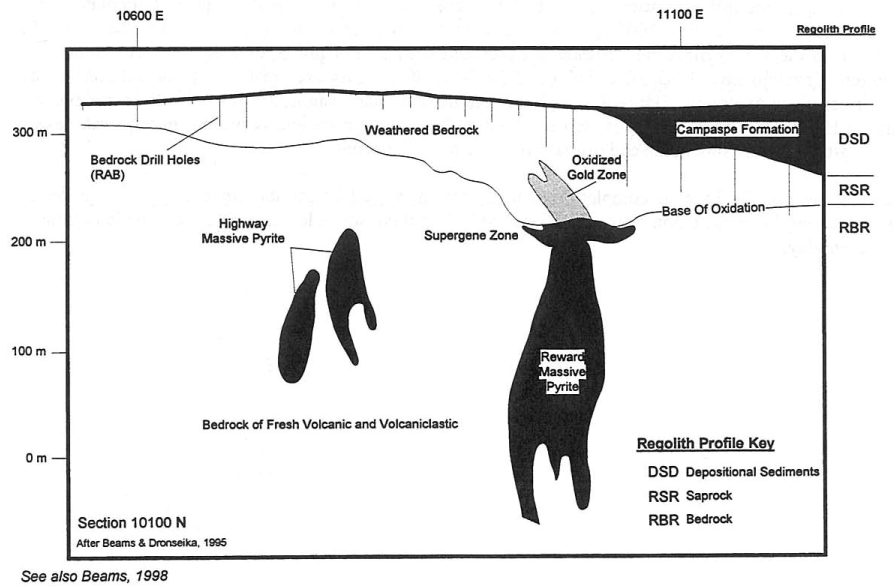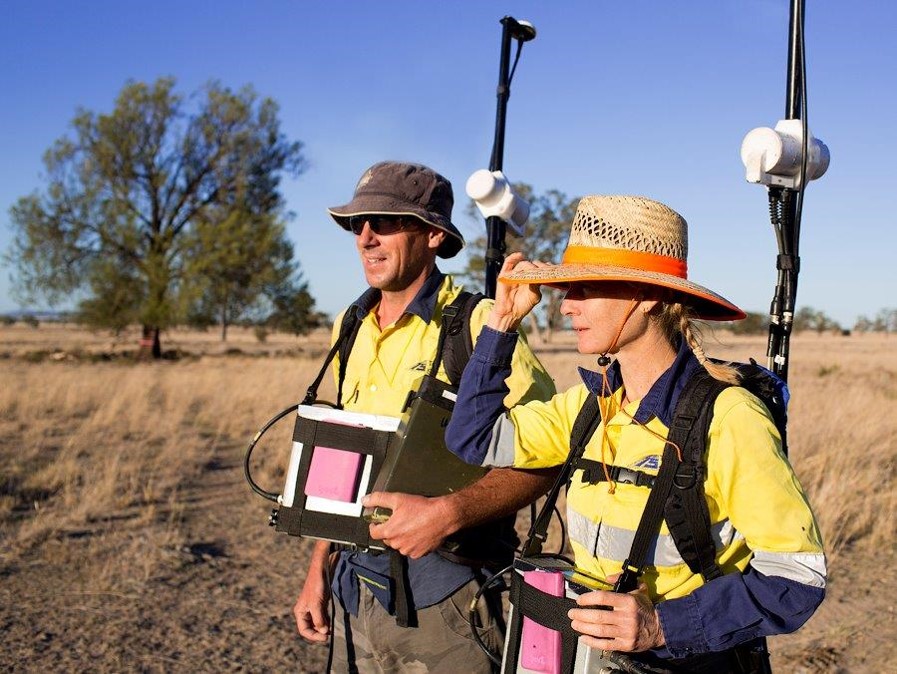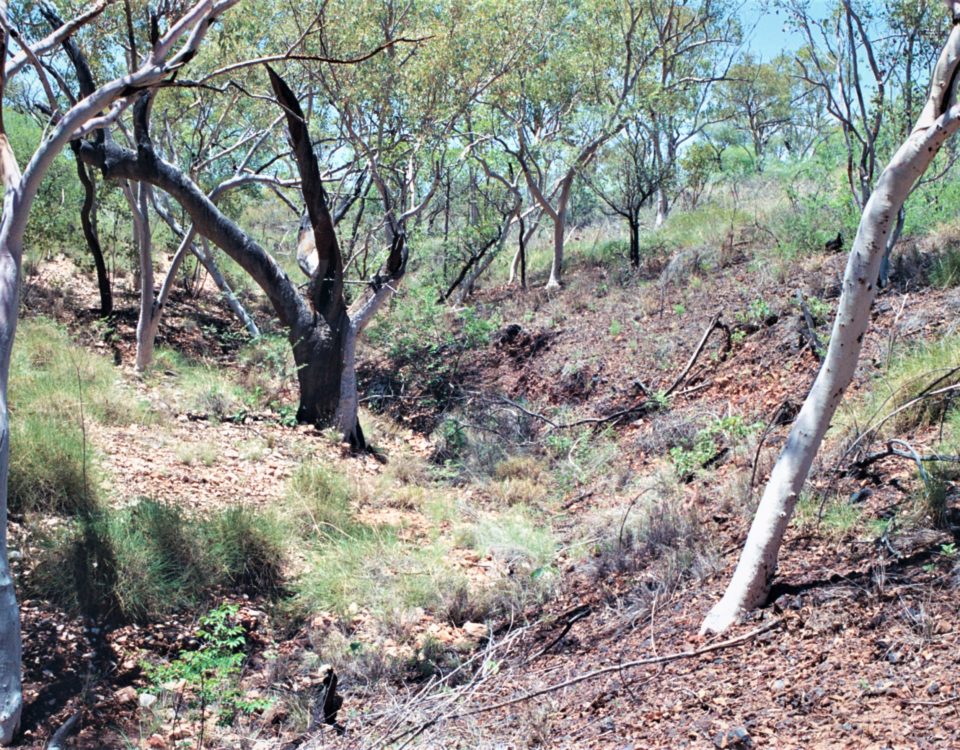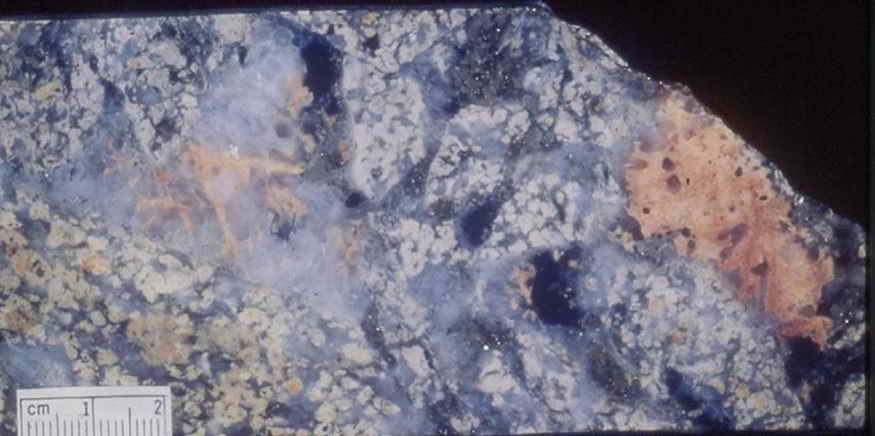
Exploration Data Management on a Mineral Province Scale
January 24, 2018
Terra Search Publications Geological Setting and Mineralisation Style of Ore Deposits of Northeast Queensland
January 24, 2018Simon D. Beams, Ed V. Dronseika, Mark G. Doyle in “Economic Geology of Northeast Queensland, the 1998 Perspective”
Please click here to download the full PDF of this publication.
See also “Reward Polymetallic Sulphide Deposit” by Beams, et al.
Introduction
The Highway-Reward volcanic-hosted massive sulfide (VHMS) deposit is situated 35 km south of Charters Towers in northern Queensland. The deposit is hosted by volcano-sedimentary rocks of the Cambro-Ordovician Seventy Mile Range Group.
The deposit comprises two main discordant pyrite-chalcopyrite pipes: Highway and Reward. Reward is a “blind” orebody and was discovered in 1987 after a long history of exploration by various companies in the area. The Highway pipe was discovered in 1990 and is located approximately 200 m NNW of the Reward orebody beneath the abandoned Highway open pit. The main Reward pyrite- chalcopyrite pipe occurs under 100 m combined thickness of Tertiary fluviatile sediments (Campaspe Formation) and deeply weathered gossanous volcanic rocks. The Highway massive sulphide
body lies beneath 100 m of weathered and Au-barite-bearing gossanous rhodolite, the bulk of which has now been mined out.
The mineralisation can be divided into five main types (Beams, et al., 1989, Doyle, 1997). These are: (1) primary pyrite-chalcopyrite pipes; (2) supergene Cu (chalcocite and covellite) and Au above the Reward pipe, (3) gossanous Cu-Au-rich mineralisation above the sulphide zone; (4) disseminated, vein- style and stratabound pyrite-sphalerite-galena-barite mineralisation at the margins of the pipes and in the hanging wall; (5) footwall and hanging wall pyrite-quartz veins.
The Reward pipe is inferred to contain in excess of 5 million tonnes of pyrite with minor primary chalcopyrite-rich zones. Overlying the primary mineralisation, a supergene chalcocite-covellite rich zone contains a resource of around 0.75 million tonnes of 8.7% Cu. An oxide resource of 0.17 million tonnes at 3.7 g/t Au overlies the supergene zone.
The Highway body contains approximately 2 million tonnes of pyrite of which over half is mineralised significantly with interstitial chalcopyrite. This resource amounts to approximately 1.2 million tonnes at 5% Cu.
Exploration History
Recognising the possible relationship between oxide Au and primary Cu-Au at Reward, a series of diamond holes were designed to test for primary sulphide mineralisation beneath mined out oxide ore of the Highway open-pit (M. van Eck pers. comm). In January 1990, hole REMM 119 intersected the Highway massive pyrite body. In 1991, Aberfoyle acquired a 65% interest with BML Holdings (35%). BML Holdings interest was acquired by Sabminco NL in 1992. RGC Thalanga Pty Ltd have since acquired Aberfoyle’s interest and are currently developing the Highway-Reward deposit in joint venture with Grange Resources (formerly Sabminco NL).
Regional Geology
The Highway-Reward deposit is hosted within the Trooper Creek Formation (Fig. 1), one of four formations within the Seventy Mile Range Group (Henderson, 1986). The Trooper Creek Formation comprises a complex suite of rhyolitic, dacitic and andesitic lavas, syn-sedimentary intrusions, volcaniclastic rocks and volcanic and non-volcanic siltstone. Combined, features such as andesite pillow lavas, sandstone turbidites, hyaloclastite, peperite and fossils suggest a submarine below-storm-wave-base depositional setting for the bulk of the Trooper Creek Formation (e.g. Berry et al., 1992; Doyle, 1994, 1997). However, parts of the succession were deposited above storm wave base and may have been partly emergent (Doyle, 1997). The Seventy Mile Range Group has been metamorphosed to lower greenschist faces and affected by three deformations of equivocal age (e.g. Berry et al., 1992). In the east, the syn-deformational early regional metamorphic assemblage has been overprinted by hornblende hornfels assemblages, which form contact metamorphic aureoles around post-kinematic granitoids of the Lolworth-Ravenswood Batholith (Berry et al., 1992).
The Trooper Creek Formation hosts two significant massive sulfide deposits (Thalanga, Highway-Reward) and several small sub-economic prospects including Liontown, Waterloo, Handcuff, Magpie and Warrawee (Fig. 1). Thalanga is the largest known VHMS deposit in the Seventy Mile Range Group and occurs within the Trooper Creek Formation at the contact with the underlying Mount Windsor Formation (Gregory and Hartley, 1982; Gregory, et al., 1987). The remaining VHMS deposits, including Highway-Reward, occur within the Trooper Creek Formation.
Host Stratigraphy
Porphyries intruded or were overlain by a volcaniclastic and sedimentary faces association comprising suspension-settled siltstone, graded turbidic sandstone and thick, non-welded pumice- and crystal-rich
sandstone and breccia units. Pumiceous and crystal-rich deposits record episodes of explosive silicic volcanism in an extrabasinal or marginal basin environment, and were emplaced by cold water supported high-concentration turbidity currents. Andesite dykes cut across the massive sulfide and altered host rocks. The sedimentary facies that indicate a submarine, below-storm-wave-base environment of deposition for the volcanism and massive sulfide deposition. At Highway-Reward, beds generally dip (10-30°) and face southeast.
Geochemical Implications of the Regolith
Soil sampling has been effective in delineating high base metal zones in areas of outcrop. Major 300 m x 800 in anomalies with Cu greater than 120 ppm (Figure 1) Pb and Zn greater than 500 ppm occur at Highway, Handcuff and Truncheon. Where onlap onto areas of outcrop occurs, transported cover masks the soil values. Bedrock geochemical sampling in the covered areas has involved Rotary Air Blast (RAB) or Auger drilling. Figure 7 is a composite section through the Reward and Highway pipes showing the surface Pb values obtained by soil sampling together with sub-surface sampling by RAB bedrock drilling. Elevated Pb and Cu values in the 400-800 ppm and 200 to 300 ppm range respectively were present in soil sampling of the outcrop areas. The soil values dropped off rapidly to very low levels where a cover sequence of coarse boulder conglomerate, fenuginous clay rich gets and silts, lap onto the grid eastern side of the Reward deposit.
Mineralisation Styles
Assay intersections of the different styles of rnineralisation at Reward and Highway are presented in the
Table 1.
The Highway orebody comprise two to three pipes spaced less than 3 to 10 in apart or a single “dome” or “tooth-shaped” massive sulfide body. The Reward orebody consists of one main and several smaller subvertical, massive pyrite pipes. The largest pipe is saddle-shaped in plan, with a bulbous top (Figure 8). The pyrite-chalcopyrite pipes have a mineralogy dominated by pyrite and chalcopyrite, with minor tennantite, sphalerite, quartz and sericite. Pyrite is typically fine to medium grained (20-300 pm) but is coarse grained (2-5 mm) near shear zones. Pyrite is euhedral, has a lath-like habit or exhibits spongy, shredder, framboidal, or snowflake texture (Huston, 1992, Doyle, 1997). Fine-grained annealed chalcopyrite fills the interstices between pyrite crystals. Relict patches and segments of altered coherent and peperitic rhodolite and rhyodacite occur in a 1 to 10m wide zone at the margins and top of the pipes. Relict quartz phenocrysts are rarely preserved within the sulfide, but quartz and/or feldspar are common in relict volcanic intervals. Interstitial anhedral quartz constitutes up to 20 to 30% of the pipe along some contacts with the altered host rock. The quartz is intergrown with pyrite, forms patches up to 2 cm across, or occurs in bands of pyrite-quartz-barite. Contacts with the host succession are often sharp, but many are sheared. A halo of disseminated and patchy pyrite extends out into the surrounding altered rhodolite, rhyodacite, dacite or peperite.
A supergene zone occurs immediately below the base of complete oxidation (Figures 6 and 9). In this zone volcaniclastic units and coherent rhyolite are partially to almost completely replaced by sooty black or grey chalcocite and blue-grey covellite. Supergene mineralisation extends downwards into the massive pyrite where copper contents up to 40% occur over some 1 in intervals indicating semi-massive development of chalcocite and covellite.
At Reward, a gold oxide zone is sporadically developed above the base of oxidation. It consists of fine-grained siliceous breccias and orange coloured baritic gossans. Much of the silica is probably introduced during downward percolation and leaching of groundwaters. A larger pipe like baritic gold bearing gossanous breccia body is present at Highway (Figure 5). This resource was calculated by North Queensland Resources NL to contain a western zone of 45,400 tonnes @ 7.84 g/t Au and an eastern zone of lower grade 22,220 tonnes @ 1.42 g/t Au. Total production from mining in the period April to
November 1988 was in the vicinity of 9,000 ounces of Au (Lesh, 1989).
Alteration
Discussion
Beams et al. (1989) favoured emplacement of the massive pyrite pipes by fluid mass transfer processes during deformation, in a similar fashion to Elura and The Peak in NSW (Schmidt, 1990, Hinman & Scott,
1990). Nisbet (1992) reveals that cleavage consistently overprints all alteration and mineralisation and is therefore likely to be pre-cleavage or at latest very early syn-cleavage in timing. More recent work by Aberfoyle, McPhie and Large (1992) and Doyle (1994, 1997) suggests that the pyrite-chalcopyrite pipes and associated sphalerite-rich mineralisation formed at the same time and are syn-genetic VHMS in origin.
Doyle (1997) demonstrated that most of the massive sulfide ores at Highway-Reward formed by sub- seafloor replacement of rhodolite to dacite and volcaniclastic units because: (1) the mineralisation is hosted by intrusive or mass-flow emplaced units; (2) discordant and strata-bound ores contain relict patches of coherent faces or precursor volcanic particles, (3) peperite and massive sulfides are not mixed, implying sulfide deposition postdated emplacement of the enclosing succession; (4) pyrite pipes are discordant to bedding; (5) there are replacement fronts passing from strata-bound sphalerite-rich ores into discordant pyrite-pipes, (6) zones of strong quartz-sericite-alteration and pyrite veining extend into the hanging wall without any abrupt break in intensity. The distance below the seafloor at which infiltration and replacement took place is difficult to interpret, but was probably at least 60 m.
Ascending high temperature (300-350°C) hydrothermal fluids are interpreted to have been focussed within feeder zones (McPhie & Large, 1992) localised along the fractured glassy margins of the cryptodomes in the host succession (Doyle, 1997). The pyrite-chalcopyrite mineralisation progressively replaced the rhodolite to dacite intrusions, peperite and sediment. Lower temperature fluids that moved out from the margins of the pyrite-chalcopyrite pipes deposited a halo of Zn-Pb-Ba mineralisation.
The supergene (and probably oxide) mineralisation developed by downward concentration of metals during weathering of sulphide in the uppermost rhodolite unit above the pyrite-chalcopyrite pipes.
At Reward, high-grade supergene copper mineralisation is attributed to local enrichment by weathering of chalcopyrite rich lenses.
Acknowledgements
Data for this paper was collected by the authors during whilst completing exploration and research programs in the area over many years. Simon Beams was a geologist for Esso Minerals and a consultant
geologist for City Resources Limited during the discovery period. Ed Dronseika was project geologist whilst Aberfoyle Resources were involved in the project. Mark Doyle completed a PhD on the facies architecture of Reward through CODES at University of Tasmania. Research work has been supported by Aberfoyle Resources and RGC Thalanga Pty Ltd.
W.P.Laing, D.M. O’Neill, numerous geologists from various companies associated with the project in the past, Aberfoyle Resources, RGC Thalanga and joint venture partner Grange Resources are thanked for
their assistance.
Terra Search Pty Ltd helped produce the paper. Thanks to Deirdre Rodwell for typing the manuscript and Adam Scott and Jane Brealey for assistance in drafting the figures.
Please click here to download the full PDF of this publication.
See also “Reward Polymetallic Sulphide Deposit” by Beams, et al.


